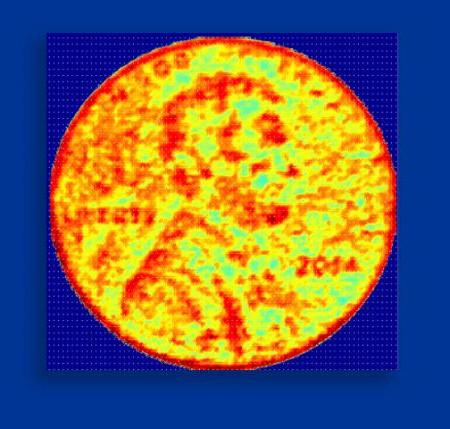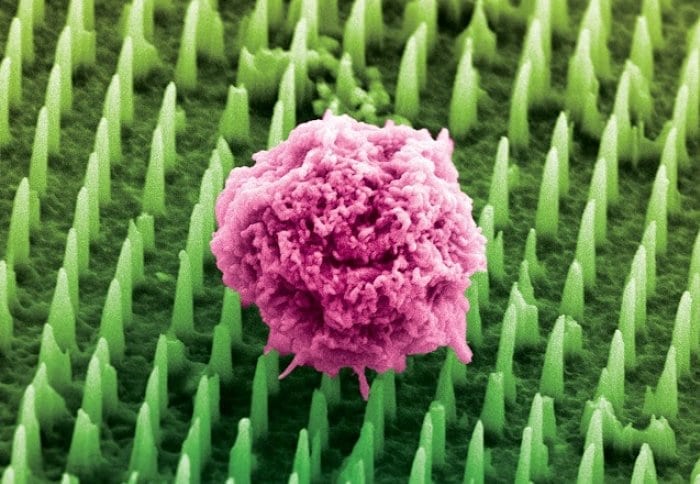
Credit: Ali Hajimiri/Caltech
Imagine you need to have an almost exact copy of an object. Now imagine that you can just pull your smartphone out of your pocket, take a snapshot with its integrated 3-D imager, send it to your 3-D printer, and within minutes you have reproduced a replica accurate to within microns of the original object.
This feat may soon be possible because of a new, tiny high-resolution 3-D imager developed at Caltech.
Any time you want to make an exact copy of an object with a 3-D printer, the first step is to produce a high-resolution scan of the object with a 3-D camera that measures its height, width, and depth. Such 3-D imaging has been around for decades, but the most sensitive systems generally are too large and expensive to be used in consumer applications.
A cheap, compact yet highly accurate new device known as a nanophotonic coherent imager (NCI) promises to change that. Using an inexpensive silicon chip less than a millimeter square in size, the NCI provides the highest depth-measurement accuracy of any such nanophotonic 3-D imaging device.
The work, done in the laboratory of Ali Hajimiri, the Thomas G. Myers Professor of Electrical Engineering in the Division of Engineering and Applied Science, is described in the February 2015 issue of Optics Express.
In a regular camera, each pixel represents the intensity of the light received from a specific point in the image, which could be near or far from the camera—meaning that the pixels provide no information about the relative distance of the object from the camera. In contrast, each pixel in an image created by the Caltech team’s NCI provides both the distance and intensity information. “Each pixel on the chip is an independent interferometer—an instrument that uses the interference of light waves to make precise measurements—which detects the phase and frequency of the signal in addition to the intensity,” says Hajimiri.
The new chip utilizes an established detection and ranging technology called LIDAR, in which a target object is illuminated with scanning laser beams. The light that reflects off of the object is then analyzed based on the wavelength of the laser light used, and the LIDAR can gather information about the object’s size and its distance from the laser to create an image of its surroundings. “By having an array of tiny LIDARs on our coherent imager, we can simultaneously image different parts of an object or a scene without the need for any mechanical movements within the imager,” Hajimiri says.
Read more: New Camera Chip Provides Superfine 3-D Resolution
The Latest on: Nanophotonic coherent imager
[google_news title=”” keyword=”Nanophotonic coherent imager” num_posts=”10″ blurb_length=”0″ show_thumb=”left”]
via Google News
The Latest on: Nanophotonic coherent imager
- Medical Imaging Newson April 25, 2024 at 5:00 pm
AI Makes Retinal Imaging 100 Times Faster, Compared to Manual Method Apr. 10, 2024 — Researchers applied artificial intelligence (AI) to a technique that produces high-resolution images of cells ...
- Space pictures! See our space image of the dayon April 25, 2024 at 9:08 am
Thursday, April 25, 2024: In this image, Russian cosmonauts Oleg Kononenko and Nikolai Chub conduct a spacewalk outside the International Space Station on April 25, 2024. The two spacewalkers will ...
- Abdominal imagingon April 23, 2024 at 5:00 pm
Feasibility of and agreement between MR imaging and spectroscopic estimation of hepatic proton density fat fraction in children with known or suspected nonalcoholic fatty liver disease.
- Radiology & Imaging newson April 22, 2024 at 4:59 pm
Uveitis is a rare inflammatory eye disease. Posterior and panuveitis in particular are associated with a poor prognosis and a protracted course of the disease. Diagnosis and monitoring can be ...
- Best AI image generators of 2024on April 18, 2024 at 5:00 pm
Creating images from a simple text prompt is one of the most well established uses for generative artificial intelligence and there are dozens of AI image generators on the market offering an ...
- The Imaging Centeron April 18, 2024 at 2:00 pm
The Imaging Center supports the study and production of the visual arts at Smith. We work with faculty and students to make art, to study art and to document art. We teach workshops and provide ...
- Imaging Science Bachelor of Science Degreeon April 9, 2024 at 5:00 pm
RIT’s imaging science bs combines physics, math, computer science, and engineering to develop cutting-edge imaging systems for satellites, drones, AR/VR, and more. Imaging science is the study of the ...
- How to tell if an image is AI-generatedon April 8, 2024 at 1:45 am
Image generators are not text generators, and creating pictures with elements that look like text is a very different job to creating actual readable text. Misspelled words, letters that blur ...
- Which Product Replaced Milwaukee's Thermal Imager & What Are They Used For?on March 29, 2024 at 6:29 pm
The Milwaukee tool company has turned 100, and it continues to gain popularity, as sales increased 10.7% in 2023, according to BizTimes. One of the highlights from this manufacturer was the ...
- R-Drive Image review: Our favorite backup gets even betteron March 29, 2024 at 3:30 am
Fast and reliable, version 7.2 of R-Drive Image adds online storage support and the ability to replicate images across multiple destinations to an already vast array of features. Our recommended ...
via Bing News









